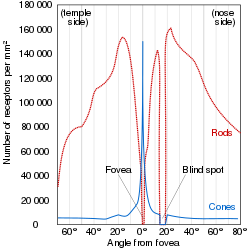| This article needs additional citations for verification. Please help improve this article by adding citations to reliable sources. Unsourced material may be challenged and removed. Find sources: "Blind spot" vision – news · newspapers · books · scholar · JSTOR (November 2011) (Learn how and when to remove this message) |
 Vertebrate
Octopus
Vertebrate
Octopus
 In vertebrate eyes, the nerve fibers route before the retina, blocking some light and creating a blind spot where the fibers pass through the retina and out of the eye. In octopus eyes, the nerve fibers route behind the retina, and do not block light or disrupt the retina. In the example, 4 denotes the vertebrate blind spot, which is notably absent in the octopus eye. In both images, 1 denotes the retina and 2 the nerve fibers, including the optic nerve (3).
In vertebrate eyes, the nerve fibers route before the retina, blocking some light and creating a blind spot where the fibers pass through the retina and out of the eye. In octopus eyes, the nerve fibers route behind the retina, and do not block light or disrupt the retina. In the example, 4 denotes the vertebrate blind spot, which is notably absent in the octopus eye. In both images, 1 denotes the retina and 2 the nerve fibers, including the optic nerve (3).

A blind spot, scotoma, is an obscuration of the visual field. A particular blind spot known as the physiological blind spot, "blind point", or punctum caecum in medical literature, is the place in the visual field that corresponds to the lack of light-detecting photoreceptor cells on the optic disc of the retina where the optic nerve passes through the optic disc. Because there are no cells to detect light on the optic disc, the corresponding part of the field of vision is invisible. Via processes in the brain, the blind spot is interpolated based on surrounding detail and information from the other eye, so it is not normally perceived.
Although all vertebrates have this blind spot, cephalopod eyes, which are only superficially similar because they evolved independently, do not. In them, the optic nerve approaches the receptors from behind, so it does not create a break in the retina.
The first documented observation of the phenomenon was in the 1660s by Edme Mariotte in France. At the time it was generally thought that the point at which the optic nerve entered the eye should actually be the most sensitive portion of the retina; however, Mariotte's discovery disproved this theory.
The blind spot in humans is located about 12–15° temporally and 1.5° below the horizontal and is roughly 7.5° high and 5.5° wide.
Blind spot test
| Demonstration of the blind spot | ||||
|---|---|---|---|---|
| R | L | |||
| Instructions: Close one eye and focus the other on the appropriate letter (R for right or L for left). Place your eye a distance from the screen approximately equal to three times the distance between the R and the L. Move your eye towards or away from the screen until you notice the other letter disappear. For example, close your right eye, look at the "L" with your left eye, and the "R" will disappear. | ||||
Night blind spot

It is estimated that once fully adapted to darkness, the rods are 10,000 times more sensitive to light than the cones, making them the primary receptors for night vision. Since the cones are concentrated near the fovea, the rods are also responsible for much of the peripheral vision. The concentration of cones in the fovea can make a night blind spot in the center of the field of vision.
See also
References
- Brian A. Wandell (1 January 1995). Foundations of Vision. Sinauer Associates. ISBN 978-0-87893-853-7.
- Gregory, R., & Cavanagh, P. (2011). "The Blind Spot". Scholarpedia. Retrieved on 2011-05-21.
- MIL-STD-1472F, Military Standard, Human Engineering, Design Criteria For Military Systems, Equipment, And Facilities (23 Aug 1999) PDF
- "Chapter 17: Aeromedical Factors". Pilot's Handbook of Aeronautical Knowledge (FAA-H-8083-25C ed.). Federal Aviation Administration. 2023-07-17. p. 22.
 This article incorporates text from this source, which is in the public domain.
This article incorporates text from this source, which is in the public domain.
| Phenomena of the visual system | |
|---|---|
| Entoptic phenomena | |
| Other phenomena | |